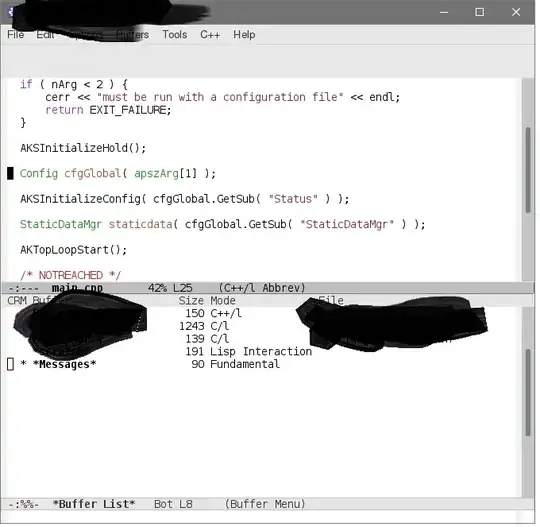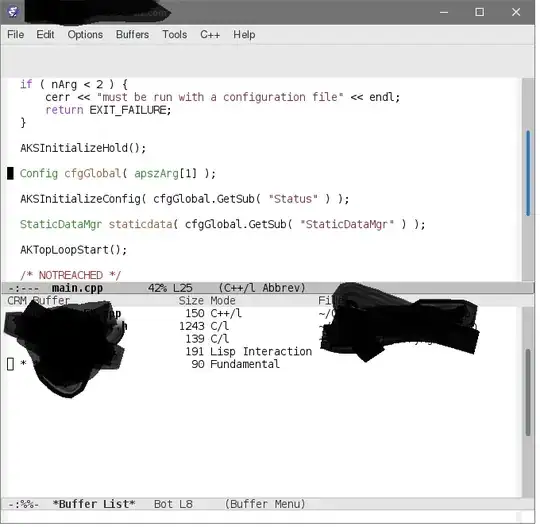The problem manifests on:
- Emacs 26.3 on Fedora Release 31, using Xming on Windows 7 as X server, whether in -Q mode or not
- Emacs 24.3 on RHEL7, using MobaXterm 12.2 4204, whether in -Q mode or not
The scrollbar I'm seeing is a medium-dark rectangle (the scrollbar "elevator") with rounded left-hand corners and square right-hand corners (which may have been a wide-scrollbar setting on 26.3; on 24.3 it's as pictured below) in a light-gray vertical area (the scrollbar "track"). When I mouse over the rectangle it switches to dark gray.
When I click it, it turns blue. After about 1/2 second, if not moved, it narrows about 2 pixels on both sides]**, and refuses to move. Moving the mouse will sometimes get one scroll of the window contents, and sometimes not.
If I click it and move it slightly in that 1/2 second, it will move, and continue to be movable even if I hold still for a while. But I have to move it substantially (at least half its height, it seems, in a 2000 line file) or it will then freeze at the 1/2 second mark.
Here's my current .emacs file:
(defun switch-to-next-buffer-frank ()
(interactive)
(switch-to-buffer (other-buffer)))
(defun switch-to-prev-window ()
(interactive)
(other-window -1))
(defun scroll-one-line-up (&optional arg)
"Scroll the selected window up (forward in the text) one line (or N lines)."
(interactive "p")
(scroll-up (or arg 1)))
(defun scroll-one-line-down (&optional arg)
"Scroll the selected window down (backward in the text) one line (or N)."
(interactive "p")
(scroll-down (or arg 1)))
(global-set-key [(control ?z)] 'scroll-one-line-up)
(global-set-key [(meta ?z)] 'scroll-one-line-down)
(global-set-key [(meta ?g)] 'goto-line)
(global-set-key [(control ?x)(k)] 'kill-this-buffer)
(global-set-key [(control meta ?l)] 'switch-to-next-buffer)
(global-set-key [(control shift meta ?l)] 'switch-to-prev-buffer)
(global-set-key [(control tab)] 'other-window)
(global-set-key [(control shift iso-lefttab)] 'switch-to-prev-window)
(modify-syntax-entry ?_ "w")
(setq scroll-bar-mode 'left)
(setq scroll-bar-adjust-thumb-portion nil)
(setq gutter-buffers-tab-visible-p nil)
(setq inhibit-startup-screen t)
(setq mouse-yank-at-point t)
(setq inhibit-startup-buffer-menu t)
(tool-bar-mode -1)
(delete-selection-mode 1)
;(setq inhibit-splash-screen t)
;(setq inhibit-startup-message t)
;(setq initial-scratch-message nil)
;(delete-selection-mode 1)
;
;(defun ask-user-about-supersession-threat (fn)
; "blatantly ignore files that changed on disk"
; )
(custom-set-variables
;; custom-set-variables was added by Custom.
;; If you edit it by hand, you could mess it up, so be careful.
;; Your init file should contain only one such instance.
;; If there is more than one, they won't work right.
'(ansi-color-faces-vector
[default default default italic underline success warning error])
'(ansi-color-names-vector
["#3F3F3F" "#CC9393" "#7F9F7F" "#F0DFAF" "#8CD0D3" "#DC8CC3" "#93E0E3" "#DCDCCC"])
'(background-color "#000000")
'(background-mode dark)
'(company-quickhelp-color-background "#4F4F4F")
'(company-quickhelp-color-foreground "#DCDCCC")
'(cursor-color "#ffffff")
'(custom-enabled-themes (quote (manoj-dark)))
'(custom-safe-themes
(quote
("54f2d1fcc9bcadedd50398697618f7c34aceb9966a6cbaa99829eb64c0c1f3ca" "4138944fbed88c047c9973f68908b36b4153646a045648a22083bd622d1e636d" "8885761700542f5d0ea63436874bf3f9e279211707d4b1ca9ed6f53522f21934" "59e82a683db7129c0142b4b5a35dbbeaf8e01a4b81588f8c163bd255b76f4d21" default)))
'(fci-rule-color "#383838")
'(font-use-system-font t)
'(foreground-color "#00ff00")
'(gutter-buffers-tab-visible-p nil t)
'(indent-tabs-mode nil)
'(nrepl-message-colors
(quote
("#CC9393" "#DFAF8F" "#F0DFAF" "#7F9F7F" "#BFEBBF" "#93E0E3" "#94BFF3" "#DC8CC3")))
'(pdf-view-midnight-colors (quote ("#DCDCCC" . "#383838")))
'(query-user-mail-address nil)
'(tool-bar-mode nil)
'(user-mail-address "fsheeran@gmail.com")
'(vc-annotate-background "#2B2B2B")
'(vc-annotate-color-map
(quote
((20 . "#BC8383")
(40 . "#CC9393")
(60 . "#DFAF8F")
(80 . "#D0BF8F")
(100 . "#E0CF9F")
(120 . "#F0DFAF")
(140 . "#5F7F5F")
(160 . "#7F9F7F")
(180 . "#8FB28F")
(200 . "#9FC59F")
(220 . "#AFD8AF")
(240 . "#BFEBBF")
(260 . "#93E0E3")
(280 . "#6CA0A3")
(300 . "#7CB8BB")
(320 . "#8CD0D3")
(340 . "#94BFF3")
(360 . "#DC8CC3"))))
'(vc-annotate-very-old-color "#DC8CC3"))
(custom-set-faces
;; custom-set-faces was added by Custom.
;; If you edit it by hand, you could mess it up, so be careful.
;; Your init file should contain only one such instance.
;; If there is more than one, they won't work right.
'(default ((t (:foreground "#00ff00" :background "#000000" :size "10pt" :family "DejaVu Sans Mono" :foundry "PfEd" :slant normal :weight normal :height 144 :width normal))))
'(font-lock-builtin-face ((t (:foreground "#00ccff"))))
'(font-lock-comment-delimiter-face ((t (:foreground "#ffff00" :slant normal))))
'(font-lock-comment-face ((t (:foreground "#ffff00" :slant normal))))
'(font-lock-constant-face ((t (:foreground "#00ff99" :weight normal))))
'(font-lock-function-name-face ((t (:foreground "#00ff00" :weight normal :height 1.0))))
'(font-lock-preprocessor-face ((t (:foreground "#ff4040"))))
'(font-lock-string-face ((t (:foreground "#00ffee"))))
'(font-lock-type-face ((t (:foreground "#33ccff"))))
'(font-lock-variable-name-face ((t (:foreground "#66ff00"))))
'(italic ((t nil)))
'(mode-line ((t (:background "#445555" :foreground "#ffffff" :box (:line-width 2 :color "#445555") :height 1.0))))
'(mode-line-buffer-id ((t (:background "#445555" :foreground "#55ff55" :weight normal :height 1.0))))
'(mode-line-emphasis ((t (:weight normal))))
'(mode-line-highlight ((t (:box (:line-width 2 :color "#445555")))))
'(mode-line-inactive ((t (:background "#445555" :foreground "#ffffff" :box (:line-width 2 :color "#445555") :weight normal :height 1.0))))
'(scroll-bar ((t (:background "#334444" :foreground "#ddffff")))))
Here's a screenshot: of emacs -Q 24.3/RHEL7/MobaXterm:
Then here is the same window after I've held the top scrollbar about 1 second without moving after clicking down: